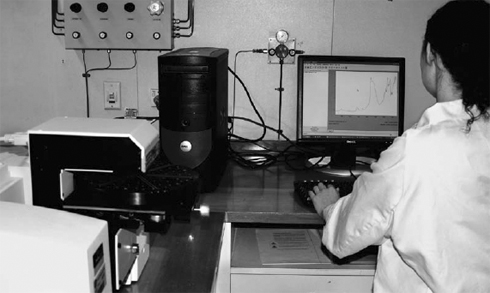
NIR diffuse reflectance spectroscopy for TSN relies on absorbances in the NIR spectral region from overtones and combination bands of fundamental absorbances. The relationship between these absorbances and one or more of the ‘conventional’ methods for TSN may come from generic relationships from a spectral library or by establishing calibrations in-house, usually 1:1 continuous relationships across the soil concentration range. Coefficients of determination for validation samples of ≥0.85–0.9 should be achievable.
Figure 7.6. An MIR instrument in operation.
Stabilise and verify the set-up and operating performance of the NIR spectrometer, usually incorporating an auto-focussing diffuse reflectance accessory or capability. Also confirm the ‘standard calibration’ for the 7A–TSN ‘conventional’ method of preference. For example, if there is need to deal with the possible presence of elevated NO3-N, then the preferred ‘conventional’ method would be 7A3 or 7A4.
Load the instrument’s auto-sampler with ‘unknown soils’, previously dried to ≈40°C and finely ground (e.g. <0.5 mm) to lessen sample heterogenerity. Typically, the instrument or its associated computer will integrate the spectral signals with the calibration equation/s to provide the result without further calculation, subject to the moisture status of the conventional method’s results. If these were expressed on an oven-dry basis, no adjustment for residual moisture in the sample is required. If the calibration equations were based on conventional measurements expressed on an air-dry basis (≈40°C), then the NIR results will need to be adjusted for residual moisture using relevant air-dry moisture to oven-dry moisture ratios.
Report TSN (% N) by NIR on an oven-dry basis. Refer, if necessary, to Method 2A1 for guidance with regard to this soil moisture calculation.